
Lopapeysa: Ultimate Guide to Traditional Icelandic Sweaters and Wool

- The Icelandic Lopapeysa Sweater
- What Makes a Lopapeysa Authentic?
- The Different Patterns of Lopapeysa
- How to Wear a Lopapeysa Sweater
- How to Clean a Lopapeysa Wool Sweater
- Best Places to Get an Authentic Lopapeysa Sweater
- Where to Buy a Lopapeysa in Reykjavik
- Where to Buy a Lopapeysa Around Iceland
- The Woolen Circle
- How Much Does an Authentic Lopapeysa Sweater Cost?
- How to Knit a Lopapeysa
- The Icelandic Wool
- Types of Lopi Wool
- The Icelandic Sheep
- History of the Lopapeysa Sweater
- The Popularity of the Lopapeysa Today
- Other Icelandic Wool Souvenirs
- Summary of the Lopapeysa Sweater and Icelandic Wool

During the height of the Icelandic winter, there are few things as comforting as a cozy wool sweater, hat, mittens, and socks. It's the perfect way to keep warm and toasty during those colder days, so it's no wonder that Icelanders have a long and rich history when it comes to wool clothing.
The most iconic piece of Icelandic wool clothing is undoubtedly the lopapeysa sweater. The name simply means an unspun-wool sweater, as "lopi" refers to a type of unspun wool, and "peysa" is the Icelandic word for a sweater.
In recent years, it has become one of the most recognizable parts of Icelandic culture on the international stage, and this popularity means it can be easy to find during a visit! Whether you're staying in a hotel in Reykjavik or are planning to explore Iceland with a rental car, you can easily find stores selling authentic handmade lopapeysa around the country.
The lopapeysa makes for the perfect layering piece, offering warmth and protection from the elements. It's especially great for trying some winter experiences in Iceland, as you'll get to enjoy the full benefits of your cozy sweater! Don't miss out on these iconic sweaters during your visit, as a lopapeysa is one of the best souvenirs you can get. Read on for everything you need to know about this famous Icelandic sweater.
- See also: The Top 10 Souvenirs from Iceland
- Plan your trip with Iceland in Winter - The Ultimate Travel Guide
The Icelandic Lopapeysa Sweater
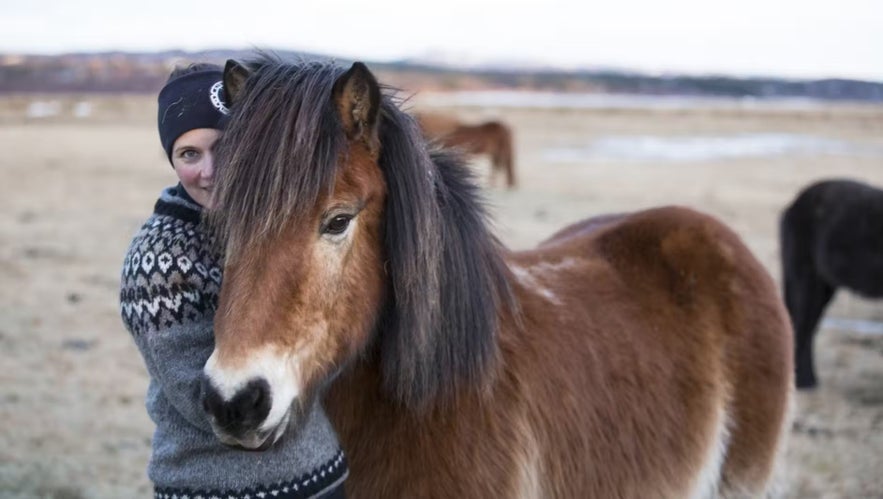
Photo from Family-Friendly 1-Hour Horse Riding Tour with Lunch & Geothermal Pool Bathing.
The Icelandic lopapeysa sweater is known for offering great protection against the North Atlantic climate. It's knitted from the wool of Icelandic sheep and has to meet certain criteria to be considered authentic.
The most prominent feature of the traditional sweater is the circular yoke pattern, which is a decorative ring of patterns around the neckline and shoulders. It's generally accentuated by contrasting colors. The sweater may also include smaller patterns on the cuffs and hem.
The fit is characterized by drop shoulders as the sleeves of the sweater are attached slightly lower on the body. This gives a relaxed and casual look while allowing for ease of movement.
A classic Icelandic jumper is closed in the front, but you can find open ones that have buttons or a zipper. These can be a great option for children's sweaters! You can also choose from a low or high neckline, and some even have a hood attached.
Traditionally, the sweater features the natural colors of sheep wool, meaning white, brown, gray, and black. Today, however, you can find them in all sorts of colors!
What Makes a Lopapeysa Authentic?
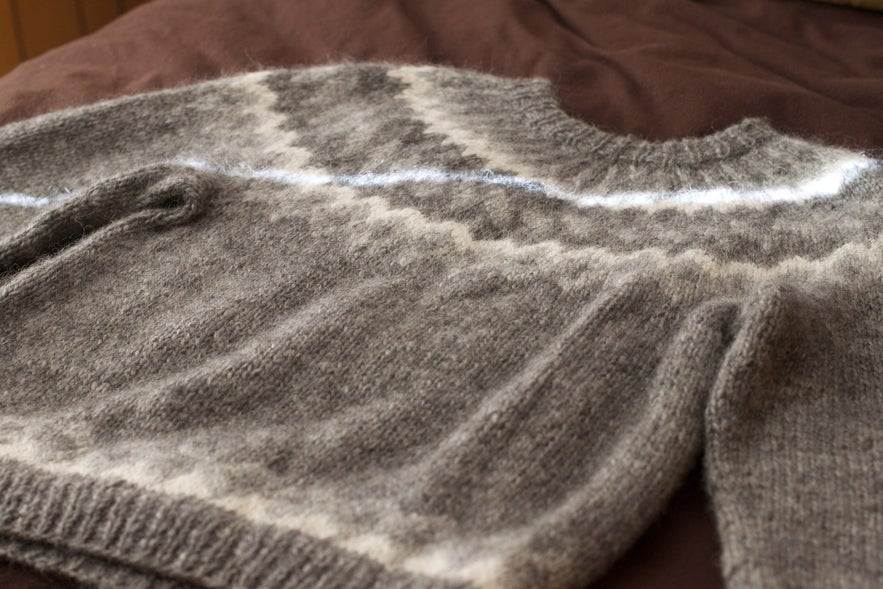
Photo from Wikimedia, Creative Commons, by cogdogblog. No edits made.
While in Iceland, you can find a lot of great outdoor wear that takes inspiration from the style of the lopapeysa. Generally, this is perfectly fine and can look very nice as long as the seller is not claiming that the product is authentic.
Unfortunately, there are examples of local stores labeling products as lopapeysa when they're not actually made in Iceland. Some are even made by machines or from the wrong material!
This is a problem because, since 2020, the lopapeysa sweater has a protected designation of origin, meaning not just anything can be labeled as a lopapeysa. For a sweater to qualify, the wool used must have been sheered from Icelandic sheep, and it must be new, not recycled. The sweater has to be knitted from Icelandic lopi, a kind of un-spun wool, and it has to be hand-made in Iceland. There are also some specific design rules it must follow.
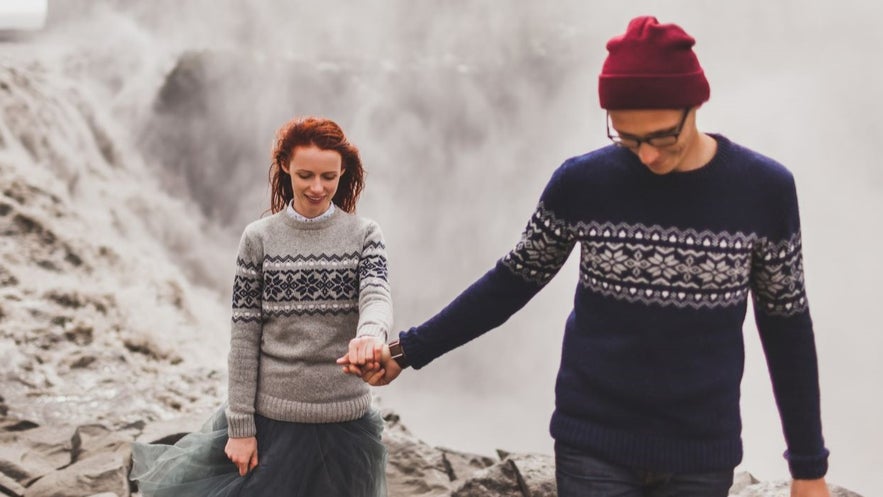
This lovely stock photo couple is wearing replicas of a lopapeysa. These sweaters are sewn together and likely not handmade or from pure lopi wool. The yoke pattern is also far too low on the body and goes around the upper arms. The photo was, however, marked as showing "traditional wool sweaters" in Iceland.
There are a few things to look for if you want to identify if a lopapeysa is authentic or not. First, see if there are any seams. An original sweater is knitted in a way that does not require any sewing, including the shoulder seams.
Then, check for information about the sweater. You'll likely find signs stating that these are authentic lopapeysa, but the seller should also be able to tell you a bit about where the sweater came from. Some Icelandic pullovers are even labeled with the name of the knitter.
You can also see if it has a material label sewn in, though this is not always the case. If there is one, it will say 100% lopi or Icelandic wool and highlight that it's handmade in Iceland. You can also feel the material, as the lopi will feel rougher than the wool you may be used to.
Lastly, check the price tag. Hand-knitting takes time and skill, and an authentic lopapeysa will not come cheap. If it sounds too good to be true, it probably is.
If you don't want to risk accidentally buying a fake lopapeysa, read on to learn about the most reliable stores to find the real thing.
The Different Patterns of Lopapeysa

Icelanders love wearing lopapeysa during cultural events. This picture is from "réttir," or sheep roundup in the fall, and shows many popular lopapeysa patterns.
If you're looking for a traditional lopapeysa sweater, you must know that there really isn't a single "authentic" lopapeysa pattern. The patterns on the yoke can be very different, but they are usually inspired by nature, history, or culture. They're geometric and repeat all around the upper body, with multiple rows of different motifs stacked on top of each other. They also feature contrasting colors to the main body of the sweater.
There can be a lot of variety between sweaters, but some types of patterns have been very popular through the decades. What many think of as a classic lopapeysa features triangle-like shapes along the top and bottom of the yoke and has a black, white, gray, and brown color combination. You can see an example in the photo below, to the bottom right. In the same photo, on both the blue sweaters to the left, you can see the "Gefjunarkeðjan" or Chain of Gefjun, which has been very popular since the 1970s and refers to the Norse goddess of plowing. It's also common to see flower motifs, like the historic "Áttblaðarós" or Eight Petal Rose, and other nature-inspired patterns.
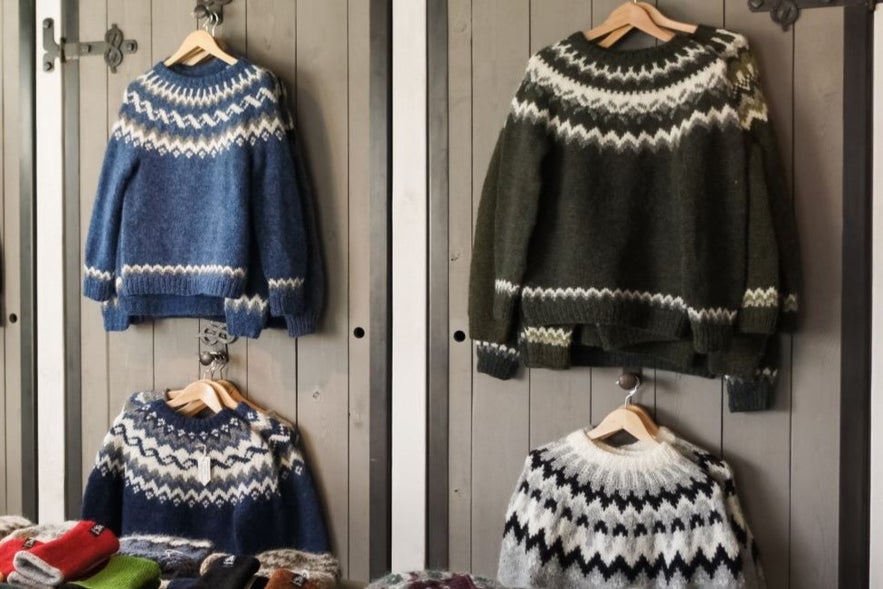
The blue sweaters on the left both feature the Chain-of-Gefjun motif. The white sweater to the bottom right features a typical triangle-shaped pattern.
The rules about what makes an Icelandic jumper a lopapeysa leave a lot of room for interpretation when it comes to the yoke patterns and colors. If you want something more modern, you can find real Icelandic wool jumpers that are colorful and bright. You can even find sweaters featuring fun images, such as of Icelandic horses, sheepdogs, or even the adorable puffin!
How to Wear a Lopapeysa Sweater
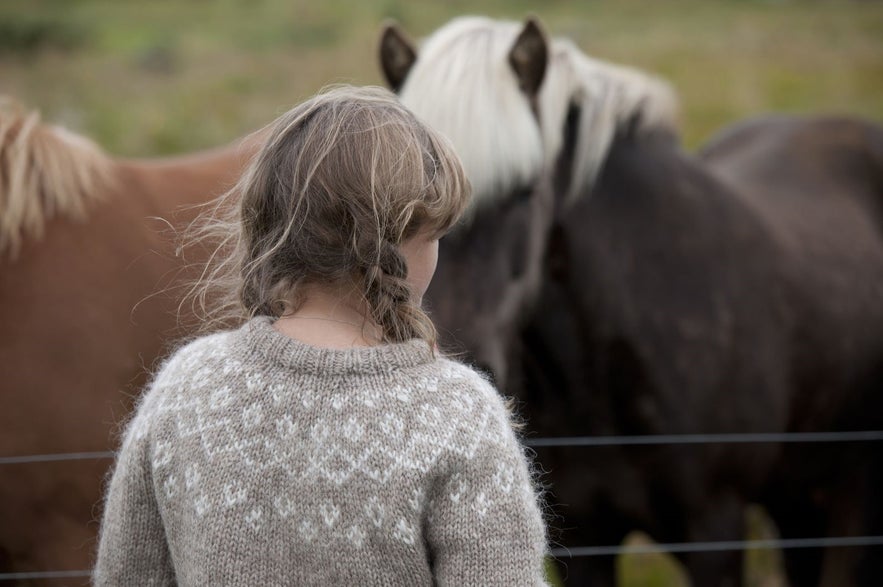 If you're not used to wearing Icelandic lopi wool, you may simply throw on your new traditional sweater over bare skin and discover, to your horror, that it's actually very itchy! But don't worry, this is perfectly normal!
If you're not used to wearing Icelandic lopi wool, you may simply throw on your new traditional sweater over bare skin and discover, to your horror, that it's actually very itchy! But don't worry, this is perfectly normal!
The wool used in an authentic lopapeysa is a bit courser than you may be used to with more common wool yarn, which is why this traditional Icelandic sweater is usually worn over an underlayer. A long-sleeve cotton t-shirt or a turtle neck is perfect for this, as it provides a soft barrier between you and the wool and lets you enjoy the full warmth of your sweater. This is also a key to getting children to wear a lopapeysa sweater, as they tend to be very sensitive to itchy materials.
If you're visiting Iceland during winter and plan to try outdoor activities like glacier hiking, ice-caving, or snowmobiling, then you can also add a light fleece layer under your lopapeysa for optimal warmth. To complete the outfit, wear a windbreaker or parka over everything to block out the elements, depending on how cold it is.
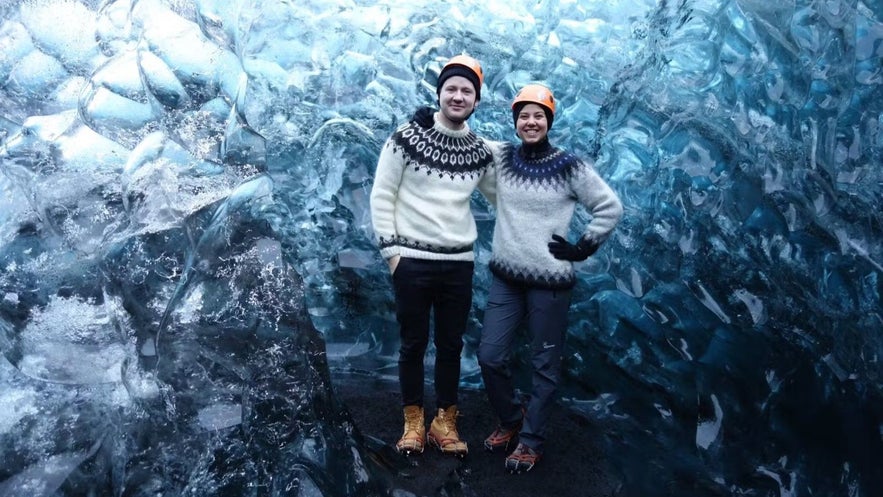
Photo from the Crystal Blue Ice Cave | Super Jeep from Jokulsarlon
This also applies if you're going on a northern lights tour. You may think you won't need that many layers, but you'll likely be standing outside for long periods of time without much movement. This means you'll feel very cold, so it's better to have too many layers than not enough! Once you return to your tour bus or rental car, you can easily remove the outer layers while staying comfortable.
- For more: What to Wear in Iceland: The Ultimate Guide for All Seasons
- See also: Northern Lights in Iceland - When & Where To See the Aurora
How to Clean a Lopapeysa Wool Sweater
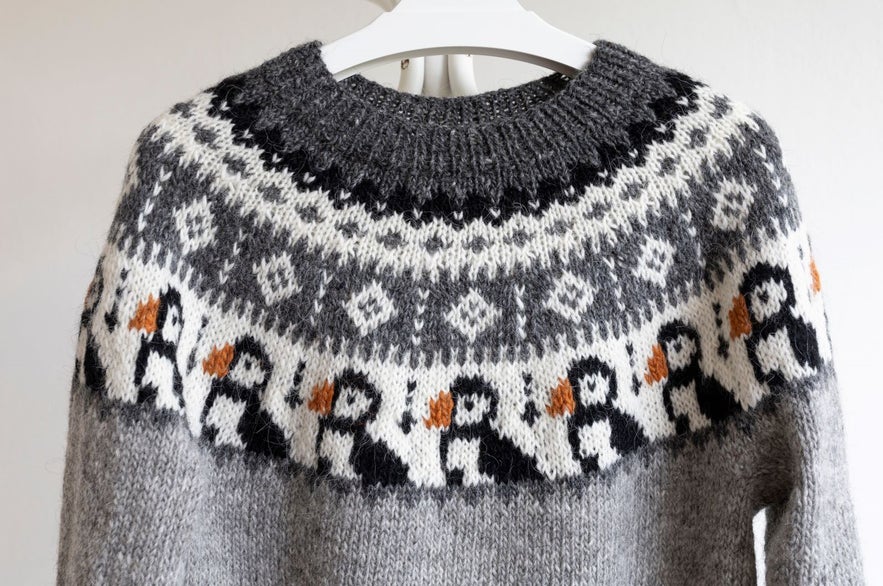
An important question you may have is how to take care of a lopapeysa sweater long-term. Icelandic wool rarely needs to be washed as it's generally not worn up against the skin, but there may come a time when it needs some refreshing.
Generally speaking, it's enough to hang your wool sweater outside for fresh air every now and then. It's also better to store it folded on a shelf, as leaving it on a hanger may stretch the sweater over time. If you really want to deep clean your lopapeysa sweater, the best way to do so is by hand washing it in warm water using a soap specially formulated for wool. If you don't have that kind of soap, a common trick is to use shampoo and hair conditioner instead, as it can help soften the wool.
Gently submerge your wool sweater and soak it for around 15 minutes. Then squeeze out excess water, but don't wring it. When drying, it's best to press it in a towel to absorb excess moisture and then lay flat to dry. If you hang it up to dry, the weight of the water will stretch the material and change the fit of the sweater!
If your sweater has a stain, it's better to spot-clean that part instead of cleaning the whole sweater. Gentleness is key, so make sure to not rub the material.
While we don't recommend it, you can use a wool program on a washing machine if you have a more durable wool sweater. Choose the slowest spin setting and use wool soap. It's also good to add a bit of hair conditioner. Then, lay flat to dry. Keep in mind that cleaning your sweater this way may damage it long-term and result in the pilling of the material. Delicate sweaters should only be hand-washed.
Best Places to Get an Authentic Lopapeysa Sweater
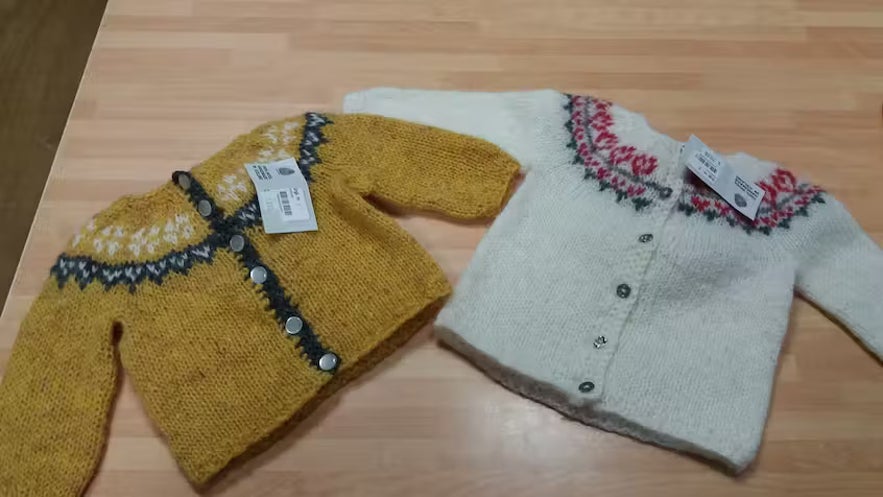
Photo from Guided 4-Hour Reykjavik Shopping Tour of Laugavegur & Kringlan or Smaralind Mall. Lopapeysa sweaters are a popular gift for children.
You can find Icelandic wool sweaters and accessories all around the country, but not all of them qualify as authentic lopapeysa. Here are the best locations to find your perfect sweater!
Where to Buy a Lopapeysa in Reykjavik
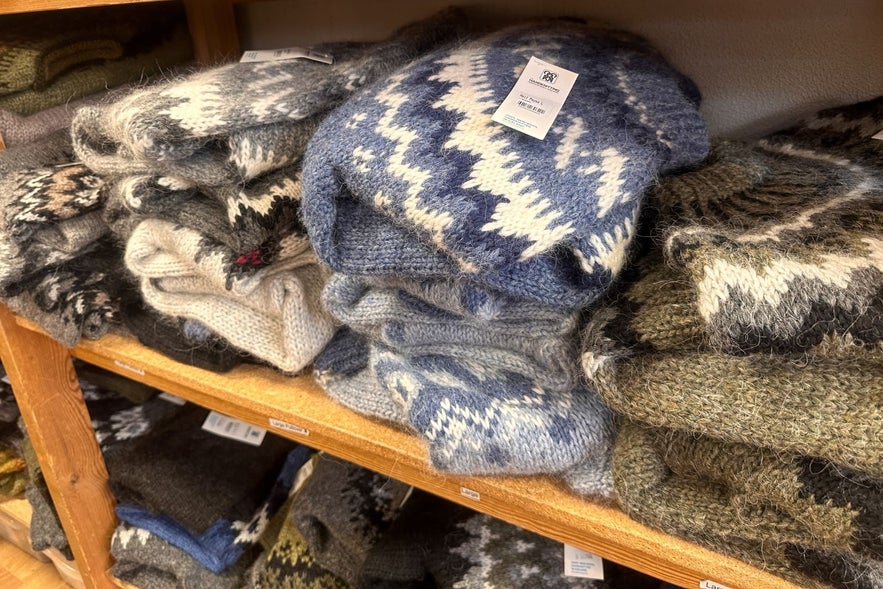 The best place to find an authentic lopapeysa is by visiting the Handknitting Association of Iceland, known as "Handprjónasambandið" in Icelandic, which is the main authority on this traditional wool sweater. The association was founded in 1977 and, as the name implies, is dedicated to knitting and selling locally handmade knitwear made from Icelandic wool.
The best place to find an authentic lopapeysa is by visiting the Handknitting Association of Iceland, known as "Handprjónasambandið" in Icelandic, which is the main authority on this traditional wool sweater. The association was founded in 1977 and, as the name implies, is dedicated to knitting and selling locally handmade knitwear made from Icelandic wool.
Their main location is on Skolavordustigur street in the center of Reykjavik, where you'll also find the famous painted rainbow that leads up to the Hallgrimskirkja church. You can be sure that all of their lopapeysa sweaters are authentic, and you'll have an overwhelming amount of options to choose from!
Make sure to take good time to find your perfect sweater, though it can be really hard to choose just one! They also sell other wool products, like socks, hats, and mittens, so you can have a complete wool outfit and achieve optimal toasty comfort.
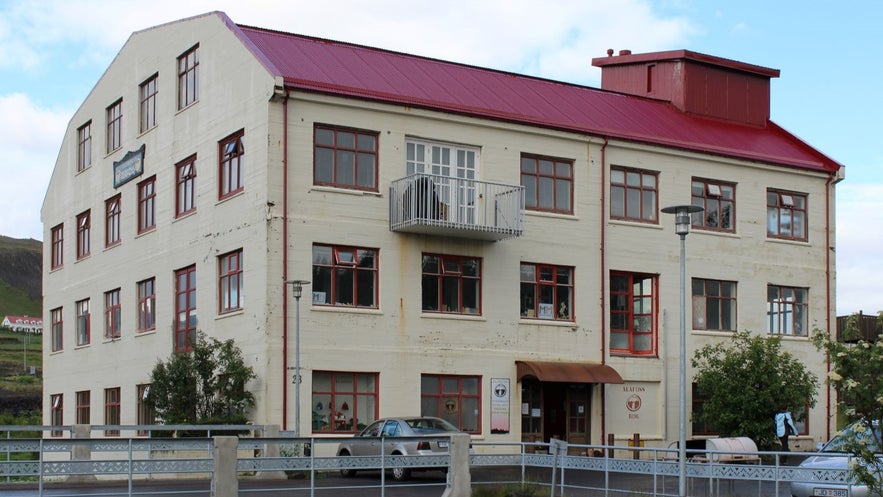
The historic Alafoss wool factory in Mosfellsbaer.
Another iconic location for authentic lopapeysa is Alafoss, the main producer of lopi wool in Iceland. They have been producing wool since 1896! Their store is located in the town of Mosfellsbaer, on the edge of the Capital Region, and it's a must-stop if you're in the area.
If you have a rental car in Reykjavik, you can easily reach the Alafoss store in about 20 minutes from the city center. You can also take the public bus, though this will take around 45 minutes.
Alafoss is a great place to pick up lopi wool, and they also sell real wool sweaters. Additionally, if you happen to have a difficult time finding the one true sweater of your dreams, you can custom order a tailor-made lopapeysa online on their website for the perfect fit!

Traditional Icelandic wool jumpers for sale in the Kolaportid flea market.
You can also find lopapeysa being sold in second-hand stores and markets. You may even be able to buy straight from the person who made the sweater! A great place for this is the Kolaportid fleamarket by the Old Reykjavik Harbor, where you can often get both new and vintage lopapeysa sweaters. However, it's only open on the weekends, so make sure to account for that if you plan to visit. For another second-hand lopapeysa option, you can sometimes spot relatively affordable sweaters in Red Cross stores around Iceland.
Where to Buy a Lopapeysa Around Iceland
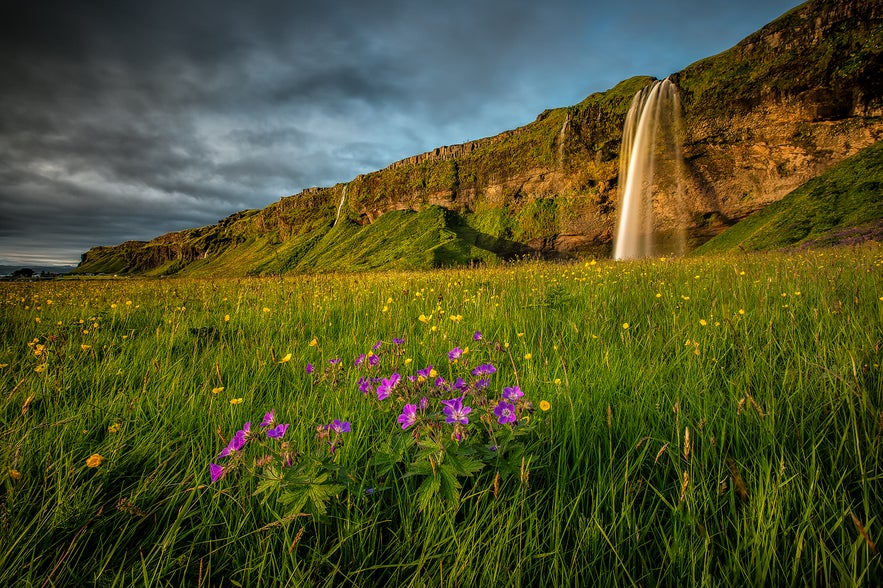 If you're planning to explore the countryside and don't have time to find a sweater in Reykjavik, you don't have to miss out! No matter where your accommodation in Iceland is located, you can likely find locations that sell them in the vicinity. Just look for handcraft stores or small souvenir shops!
If you're planning to explore the countryside and don't have time to find a sweater in Reykjavik, you don't have to miss out! No matter where your accommodation in Iceland is located, you can likely find locations that sell them in the vicinity. Just look for handcraft stores or small souvenir shops!
A great place to pick up a lopapeysa outside Reykjavik is the charming Una Local Product store, also known as "Sveitabúðin Una." It's located in the town of Hvolsvollur on the South Coast, an hour and a half drive from central Reykjavik and just a 20-minute drive from the famous Seljalandsfoss waterfall.
Make sure to visit if you're planning a tour of the South Coast, as you'll pass by on the way. It's one of the best places in Iceland for souvenirs like authentic art and handicrafts. You can also be sure that your lopapeysa was not just made in Iceland but by a local in the area! If you're traveling around West Iceland, you can stop by the Ullarselid Wool Center in the village of Hvanneyri. It's located in the picturesque Borgarfjordur fjord, an hour and 20-minute drive from Reykjavik and just a 15-minute drive from Borgarnes, the main town in the region.
If you're traveling around West Iceland, you can stop by the Ullarselid Wool Center in the village of Hvanneyri. It's located in the picturesque Borgarfjordur fjord, an hour and 20-minute drive from Reykjavik and just a 15-minute drive from Borgarnes, the main town in the region.
The Ullarselid Wool Center sells items crafted from Icelandic wool and other native materials, and you can find authentic lopapeysa sweaters made by passionate local knitters. You can also pick up some wool for your own craft projects!
Hvanneyri is known for its farming history and is the location of the Agricultural University of Iceland. The area is surrounded by lush green fields and beautiful mountains, and you can find locations like the Hraunfossar and Barnafoss waterfalls, the historic Reykholt, and the Krauma spa in the vicinity. Another worthy stop is the Haafell goat farm, where you can meet the unique and adorable Icelandic goat and find authentic goat products like cheese, soap, and handcraft!
You can visit Borgarfjordur as a day trip from Reykjavik or include it in a tour of the Snaefellsnes peninsula. It can also be a good idea to stay in accommodation in Borgarnes, as the region is well worth taking the time to explore.
The Woolen Circle
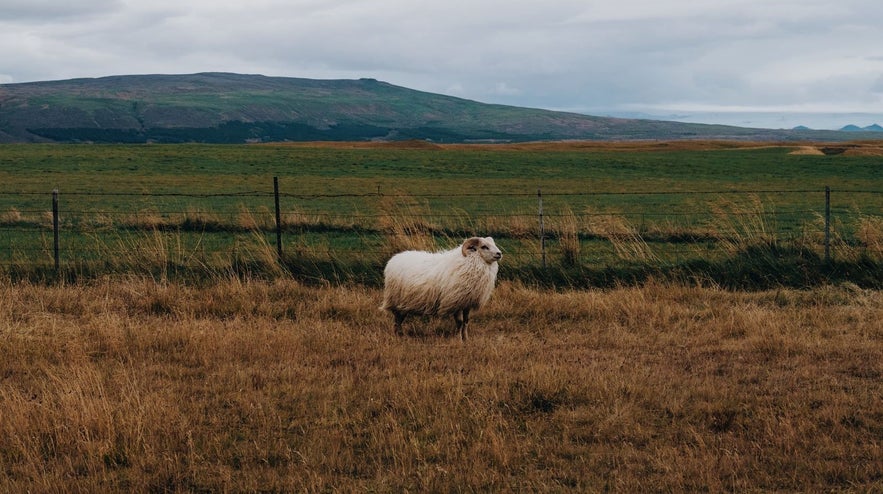
Those interested in the lopapeysa and the unique features of Icelandic wool should not miss out on the Woolen Circle route. It's connected to the famous Golden Circle route in South Iceland and is a great way to expand your trip and grab your own lopapeysa!
A tour of the Golden Circle includes three main locations; the Thingvellir National Park, the Gullfoss waterfall, and the Geysir geothermal area. The Woolen Circle adds four locations to this journey; the Hespa plant dye studio, the Thingborg wool shop, the Uppspuni Mini Mill and Yarn Shop, and the Skalholt historical site.
When visiting the Hespa dye studio, you'll learn about the traditional dyeing process and how plants can be used to create all sorts of colors. At the Thingborg wool shop, you can buy locally made lopapeysa and other wool knitwear. Then, at the family-run Uppspuni Mini Mill and Yarn Shop, you can pick up some Icelandic yarn and learn about its production! They have their own farm, and the yarn produced comes straight from their own sheep!
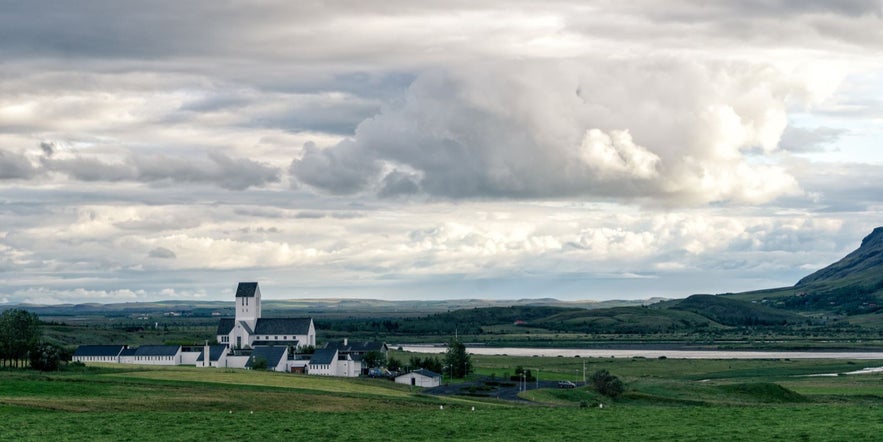
The last location, Skalholt, is one of the most historically significant places in Iceland. Established in the 11th century, it was one of Iceland's two episcopal seats, along with Holar in Hjaltadalur, a focal point for Christianity and the de facto highest seat of power in Iceland for nearly 800 years. It also housed Iceland's first school and was instrumental in the preservation of Icelandic sagas and historical records.
Through the centuries, there have been ten different cathedrals in Skalholt. That includes three grand medieval cathedrals, two of which famously burned down after being struck by lightning. The 7th cathedral to be built in Skalholt, known as Brynjolfskirkja, stood from 1650 to 1802 and can be seen on the 1000 ISK bill.
Today, you can explore the modern Skalholtskirkja cathedral, built in the mid-20th century, along with some interesting 13th-century tunnels and an archeological site. You can also find many magnificent artifacts from Skalholt at the National Museum of Iceland.
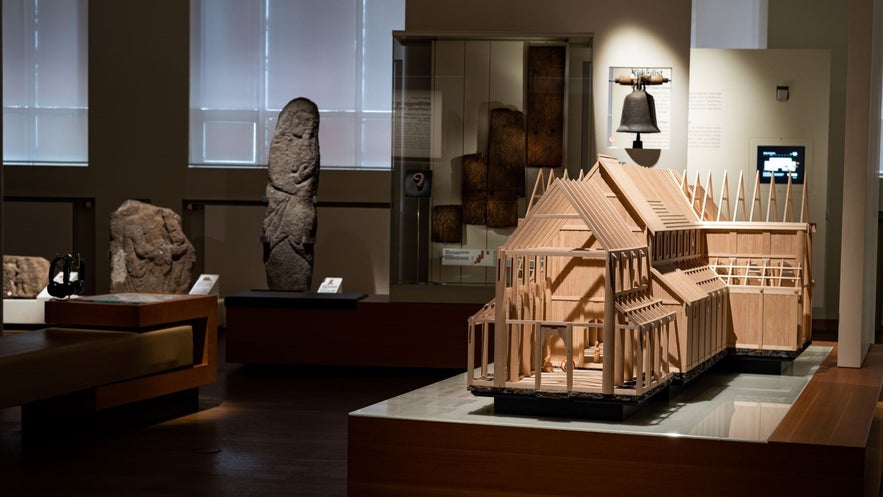
At the National Museum of Iceland, you can find a model showing what medieval cathedrals in Skalholt may have looked like.
Skalholt is around a 30-minute drive from the Gullfoss waterfall and the Geysir geothermal area, so it works as a connection point for the Woolen Circle and the Golden Circle. Doing both routes, however, will take at least 4-5 hours of driving with a small rental car.
This doesn't account for time spent on location, so while you can complete both as a self-drive day trip from Reykjavik, we recommend spreading the journey over two days and spending a night in accommodation in the Golden Circle or a hotel in Selfoss. This will make your experience stress-free and will help you account for the opening times of the Woolen Circle locations.
How Much Does an Authentic Lopapeysa Sweater Cost?
If you want a real lopapeysa sweater, it will be a bit of an investment. The average price range is between 220 USD and 440 USD (around 30 - 60,000 ISK) and can go even higher, depending on how much work and material has gone into making the sweater. If you're buying a vintage lopapeysa sweater, you may find a more affordable price range, but it probably won't be very cheap.
Keep in mind that you're not paying for fast fashion but someone's hard work, knowledge, skill, and time, along with the material cost of the sweater. Many passionate knitters also create their own patterns for the yoke, so you could be getting an original work of art.
How to Knit a Lopapeysa
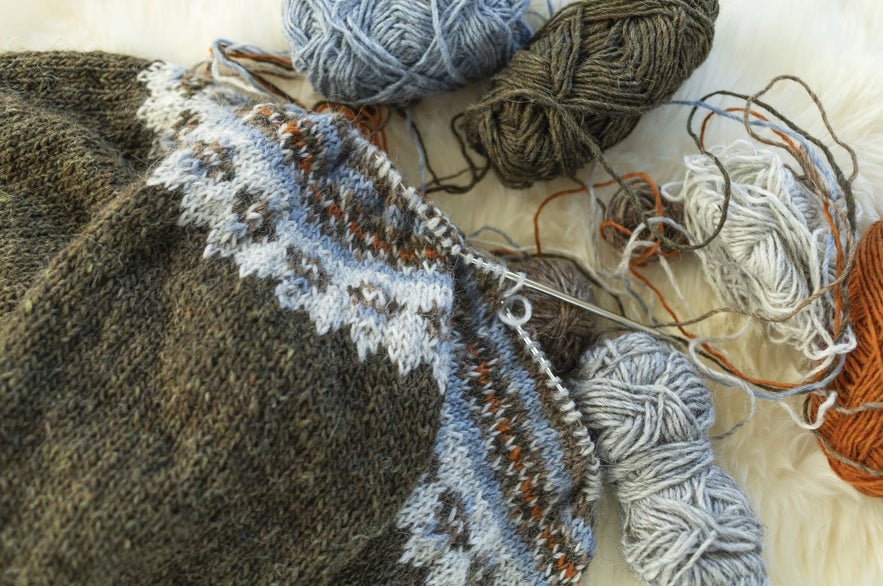 One of the main things that make a lopapeysa jumper authentic is that it's hand-knitted in Iceland, but don't let that stop you if you want to take on the project! If you follow a proper knitting pattern and use lopi wool, both of which you can order online, then we don't think anyone will really argue with you calling your own sweater a lopapeysa, even if it's not fully authentic.
One of the main things that make a lopapeysa jumper authentic is that it's hand-knitted in Iceland, but don't let that stop you if you want to take on the project! If you follow a proper knitting pattern and use lopi wool, both of which you can order online, then we don't think anyone will really argue with you calling your own sweater a lopapeysa, even if it's not fully authentic.
For your project, you'll need a large circular needle for the body, as it's knitted in the round like a tube. Then, you need smaller circular needles for the sleeves. You can also use a set of double-pointed needles if you prefer, and needle size will vary by pattern.
Then, it's time to choose your pattern! A popular place for lopapeysa patterns is Lopi Design, where you can find knitting patterns in English, German, and French. Once you've found your dream sweater, it's time to buy the material!
If you're starting your project while in Iceland, you can check out one of the many local handcraft and yarn stores, as many of them sell lopi wool. If you want to start the project before going to Iceland, you can check out Istex, where you can order a variety of authentic lopi wool online.
If you're bringing your project with you to Iceland, make sure to store it in check-in luggage during your flight, as knitting needles may be confiscated by airport security, depending on the airport!
The Icelandic Wool
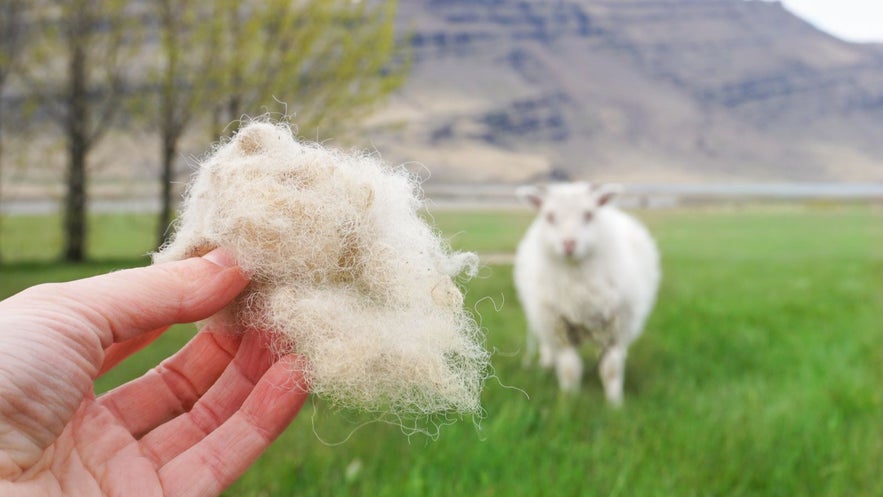 Iceland famously has some unique animal breeds, such as the Icelandic horse and the Icelandic sheepdog. What's not as often celebrated, however, are the features of the Icelandic sheep!
Iceland famously has some unique animal breeds, such as the Icelandic horse and the Icelandic sheepdog. What's not as often celebrated, however, are the features of the Icelandic sheep!
The Icelandic sheep were brought to the island at the time of settlement between 870 and 930 AD. They have been isolated since, making the modern Icelandic sheep unique. They've adapted to Iceland's environment over centuries, and their wool is famed for its durability, warmth, and water-resistant properties.
This wool retains its natural oils, lanolin, offering exceptional insulation against cold and wet conditions. It is characterized by a dual-layer structure: the outer layer, known as "tog" in Icelandic, comprises coarse fibers that are water-resistant, while the inner layer, known as "þel," consists of finer, insulating fibers. This has the amazing benefit of letting the wool keep its thermal properties when wet, which is important in a country where it sometimes rains sideways!
The combination of tog and þel wool also makes it highly versatile for knitting purposes. The tog provides structure and durability, while the þel adds softness and warmth. All of these features are what make Icelandic knitting and the lopapeysa sweater so special and beloved.
- Learn more about the Icelandic horse and the Icelandic sheepdog!
Types of Lopi Wool
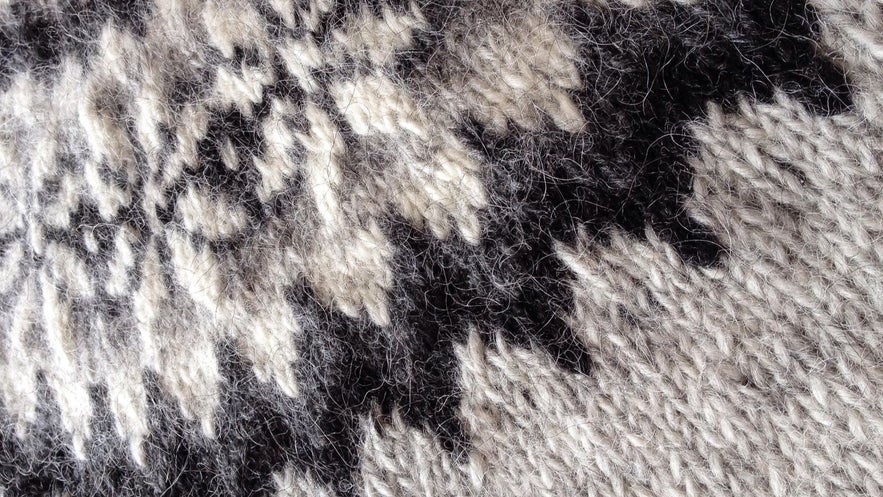
When looking for your perfect lopapeysa sweater or for other Icelandic wool products, you may see that they're made from different kinds of lopi wool. The main difference is in how the wool is worked, resulting in different qualities and uses.
- Alafosslopi: This is perhaps the most common form of lopi, known for its chunkiness and warmth. It is ideal for warm and light items like sweaters and blankets. It's great for a typical lopapeysa sweater.
- Lettlopi: This is a lighter version of Alafosslopi, suitable for garments that require warmth but are not too bulky. It’s often used for autumn sweaters, hats, and lighter outdoor clothing, offering a balance between comfort and warmth.
- Joklalopi: The name translates to "glacier lopi," and this type is even chunkier than Alafosslopi. It's very warm, and garments made from Joklalopi are typically used for more heavy-duty outdoor activities.
- Einband: This lopi is very lightweight as it's much thinner than other variants. Einband is often used for shawls, lace patterns, and lightweight sweaters. It offers the same quality of warmth and water resistance but is more delicate.
- Hosuband: This lopi is softer and smoother than other types. It's combined with nylon for added strength, and it's suitable for socks and hosiery as it's more comfortable for skin contact in tighter garments.
- Plotulopi: This is unique because it's a fully unspun wool, usually sold in flat disks called "plates." It's light and soft but can be tricky to work with, but it's perfect for those who wish to customize the thread's thickness to suit their specific project.
The Icelandic Sheep
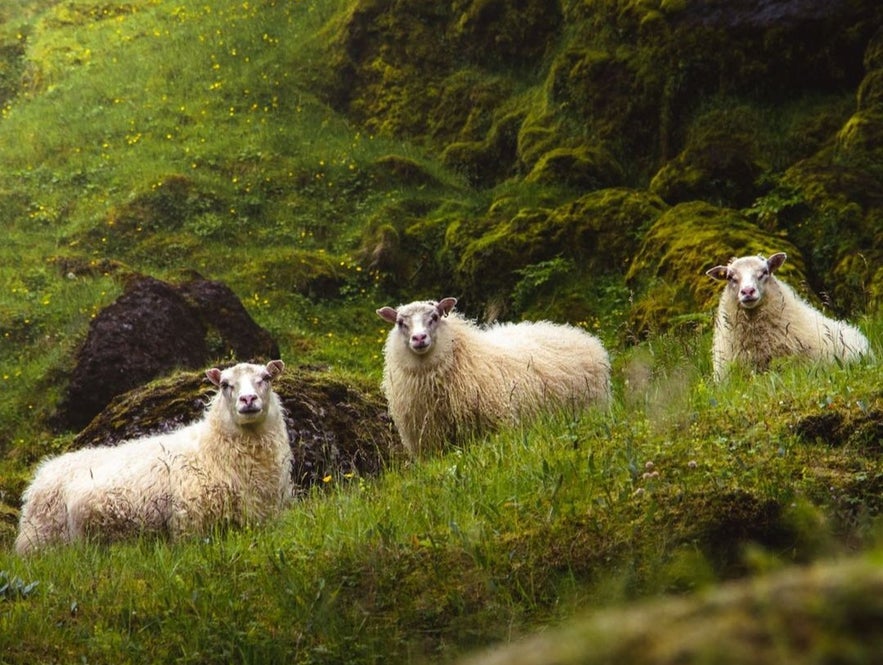 You may have heard that there are more sheep in Iceland than Icelanders, which is true! There are between 400-500 thousand sheep in the country, while the number of human habitants is just around 372 thousand. If you're planning a summer self-drive tour of Iceland, you'll see this for yourself, as you'll likely spot far more sheep than people on your travels.
You may have heard that there are more sheep in Iceland than Icelanders, which is true! There are between 400-500 thousand sheep in the country, while the number of human habitants is just around 372 thousand. If you're planning a summer self-drive tour of Iceland, you'll see this for yourself, as you'll likely spot far more sheep than people on your travels.
Icelandic sheep are very well taken care of, with very strict rules for animal welfare. They enjoy great freedom in the summer, roaming free around the wilderness during the warmer months. In the fall, they're rounded up and returned home during an event known as "réttir" to shelter them over the winter.
Apart from their wool, Icelandic sheep are also celebrated for their meat, which is tender, flavorful, and lean, mainly owing to the sheep's natural grazing habits in nature. It's a staple of Icelandic food culture, and in 2023, it received a protected designation of origin from the European Union, highlighting its uniqueness.
While Iceland has some rather infamous historical dishes, the lamb is one of the main delicious foods to try during a visit. You'll find it served in most restaurants, but for a more insightful introduction, we recommend trying it as part of this Reykjavik food walk tour. Not only will you try all sorts of local food, but you'll also learn to appreciate the lamb's place in Iceland's culinary history!
- See more: Icelandic Food: The Ultimate Guide to Iceland Food Culture
- See also: The Best Restaurants in Reykjavik
- For more on "réttir": Gathering Sheep in Árneshreppur
History of the Lopapeysa Sweater
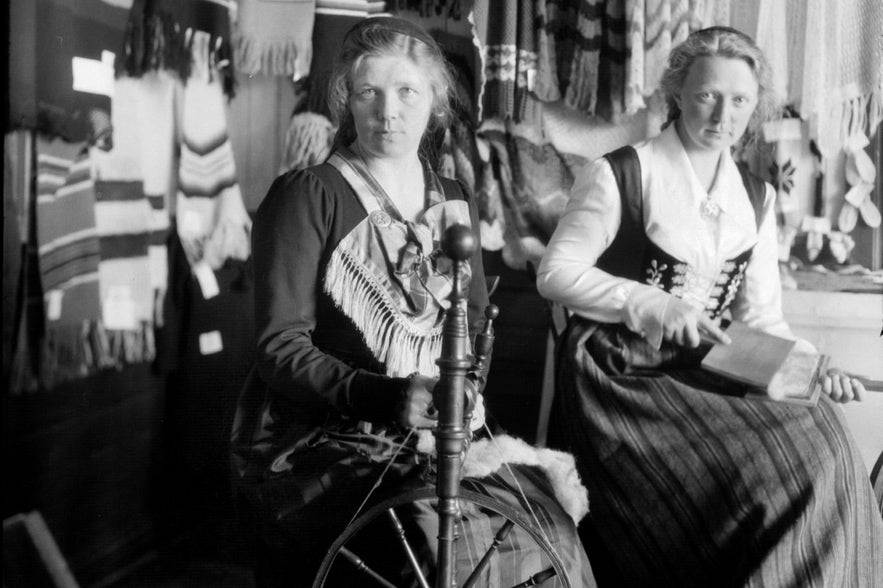
Photo from Wikimedia, Creative Commons by Magnús Ólafsson. Photo taken in 1911 of women showcasing traditional wool work at a Handcraft Exhibition.
The fabric-creation technique of knitting came to Iceland at the start of the 16th century, likely with foreign merchants. Before then, Icelanders practiced a craft known as nalbinding or knotless knitting, a method found all over Northern Europe, which is today referred to as vattarsaumur in Icelandic.
Creating clothing with this method took a long time, and when knitting came to Iceland, people were quick to adapt to the practice as it was much quicker. The resulting material also had the benefit of being stretchier than items made from knotless knitting.
Through the centuries, wool was generally spun into yarn before being knitted, which was also very time-consuming. This didn't start changing until around the start of the 20th century as a lot of people moved from the countryside to bigger towns in search of new opportunities, leaving farms with fewer workers. Another factor was the lack of imports as a result of World War I, so people started working with un-spun wool, known as lopi, to save time and to make the most of the material available.
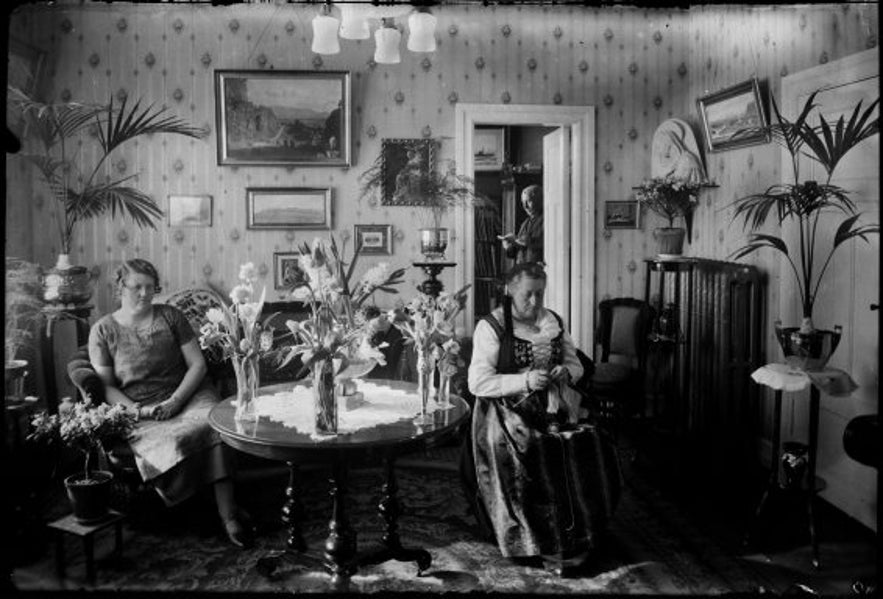
Photo from Wikimedia, Creative Commons by Magnús Ólafsson. Photo from 1910-1930 of a woman knitting in Reykjavik, wearing the national costume.
At first, sweaters made from lopi were mostly used as men's workwear, and they were especially popular among sailors. However, it only took a few years for them to become popular among all Icelanders. The design of these sweaters was influenced by foreign patterns from countries like Norway, the Faroe Islands, Greenland, and more, but with time they have gained their own identity.
The lopapeysa, as it's known today, came to be around the 1940s and 1950s as many women started knitting at home and selling for export. At the time, women would get paid between 675-900 ISK for each sweater, which took two or three days of full work.
This was not a good salary, but it did help many households stay afloat. By the late 1960s, between 40,000 and 60,000 sweaters were being exported every year, forming the idea of the Icelandic lopapeysa as a brand internationally.
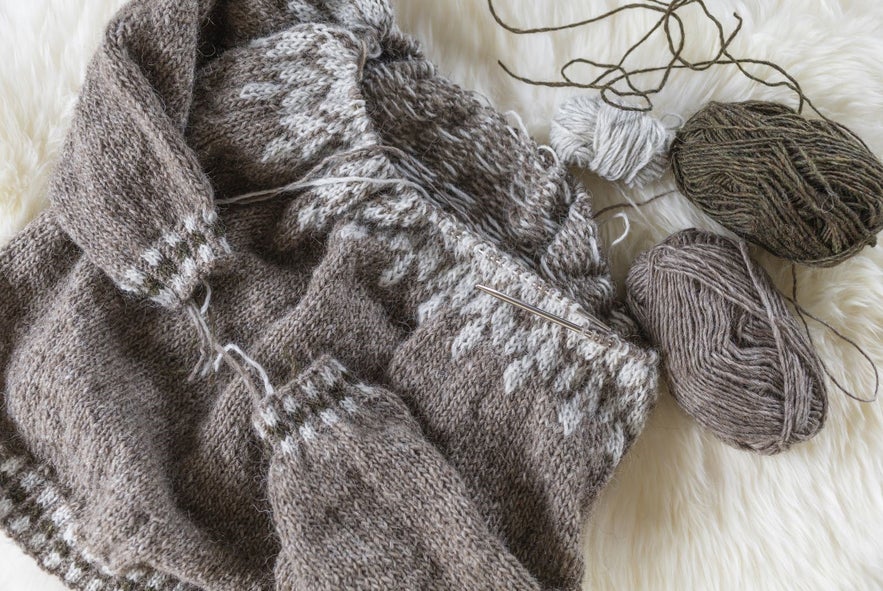
There were multiple associations of knitters founded around this time, but the most well-known came around a bit later. The Handknitting Association of Iceland was founded in 1977 and quickly became the main player in the Icelandic knitting scene, supporting the work of crafters and fighting for better pay. In its first year, it gained over 1,200 members, and though that number is lower today, it's still the main authority on the lopapeysa and the best place to get your own!
It's not known who designed the first lopapeysa sweater, but many believe it was Auður Sveinsdóttir, the wife of Nobel-prize-winning author Halldór Laxness. Auður was a great craftswoman and writer and was very influential in the development of this Icelandic jumper, but it's not known for sure if her sweater designs were the first of their kind.
The lopapeysa sweaters were common outerwear until the 1980s, when they started to lose popularity among locals. The classic wool sweater had a resurgence among knitters in the late 1990s and then regained public interest in the early 2000s as innovative designers took inspiration from the sweater for all kinds of outerwear. A new type of lopapeysa exploded in popularity around this time, which was short, tight fitting, and had a zipper in the front, leading the way for the more diverse sweaters you can find today.
The Popularity of the Lopapeysa Today
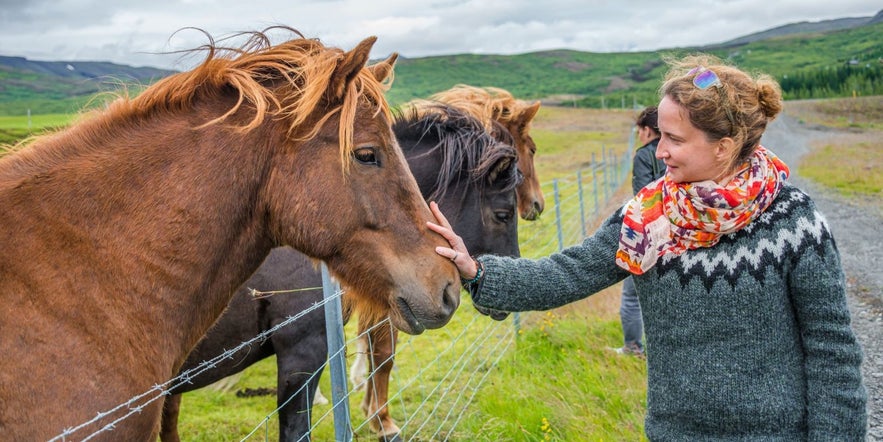 Knitting is still a very popular hobby among Icelanders, most commonly among older women. The craft form often serves as a way to socialize, as many are part of knitting and handcrafting groups, generally referred to as a "saumaklúbbur" or a sewing club. You'll also find people sharing their projects and knowledge on social media, and you can even attend an annual Knit Festival in the town of Blonduos!
Knitting is still a very popular hobby among Icelanders, most commonly among older women. The craft form often serves as a way to socialize, as many are part of knitting and handcrafting groups, generally referred to as a "saumaklúbbur" or a sewing club. You'll also find people sharing their projects and knowledge on social media, and you can even attend an annual Knit Festival in the town of Blonduos!
In recent years, there has been an increased interest in knitting among young people, as many looked for new hobbies and skills during Covid. Today, the craft form is very much thriving, and for new knitters, completing an authentic lopapeysa is considered an achievement!
The sweater is not that old in the grand scheme of things, but it's become an integral part of national expression among Icelanders. It's been with the nation since Iceland gained its independence in 1944 and has become, in many ways, an unofficial national costume. It's sometimes even given as a symbolic gift to foreign nations and world leaders!

In 2022, the Icelandic Ministry of Foreign Affairs gifted these two lopapeysa sweaters to Ukrainian President Volodymyr Zelenskyy. They were knitted by Salka Sól Eyfield, Sjöfn Kristjánsdóttir, and Eygló Gísladóttir. Photo from Salka Sól Eyfield.
Today, the lopapeysa is very popular among Icelanders and is not just a souvenir for visitors. You'll find many wearing them during events that connect to the Icelandic culture, as it's a way to embrace the shared cultural bond of those attending.
You'll see them at outdoor festivals, the yearly sheep roundup known as "réttir," or when enjoying traditional food at a Thorrablot gathering. You may also spot them on June 17th if the weather is bad on Icelands Independence Day. It's also the most perfect companion for the beautiful Icelandic nature, and if Icelanders go camping or hiking, they bring their sweater!
The lopapeysa has a special place in the hearts of Icelanders, as they're often made with love by family members, most commonly by mom or grandma. These make for cherished gifts that can last a lifetime. Their cultural significance, ties to Icelandic history, and practicality make lopapeysa jumpers one of the best things to get during your trip to Iceland.
- See also: Top 20 Festivals in Iceland
Other Icelandic Wool Souvenirs
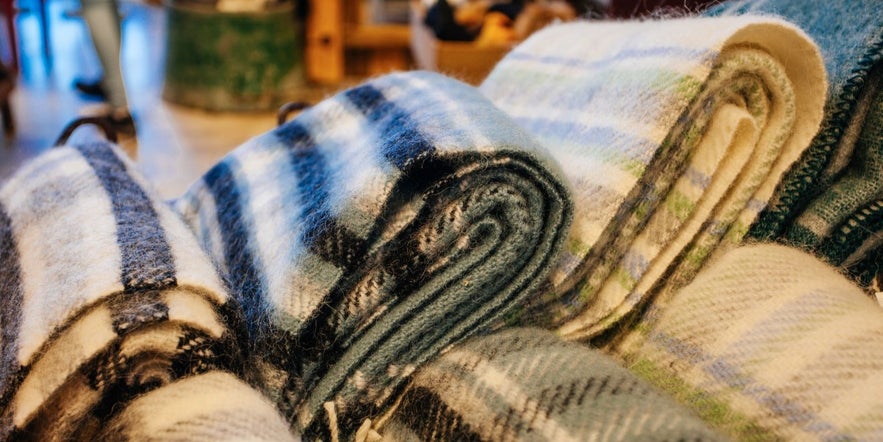 If you want some wool souvenirs for your visit to Iceland but don't want to buy a whole lopapeysa sweater, there are other fantastic items to choose from! You can find wool socks, mittens, and hats that are sure to protect you from even the toughest periods of the Icelandic winter. They're practical for your travels around Iceland and make for great souvenirs.
If you want some wool souvenirs for your visit to Iceland but don't want to buy a whole lopapeysa sweater, there are other fantastic items to choose from! You can find wool socks, mittens, and hats that are sure to protect you from even the toughest periods of the Icelandic winter. They're practical for your travels around Iceland and make for great souvenirs.
For those who don't like wearing wool, you can grab a luscious wool blanket, just make sure that you have enough space in your luggage to bring it home!
If you happen to live in a warm climate where you won't have much practical use for wool items or simply don't want to wear out your souvenir over time, we recommend picking up some traditional mittens. They're adorned with intricate patterns, and while they can certainly be worn for warmth, they're so pretty that they can be used as decor. Alternatively, you can find a variety of local art and decor made from wool!
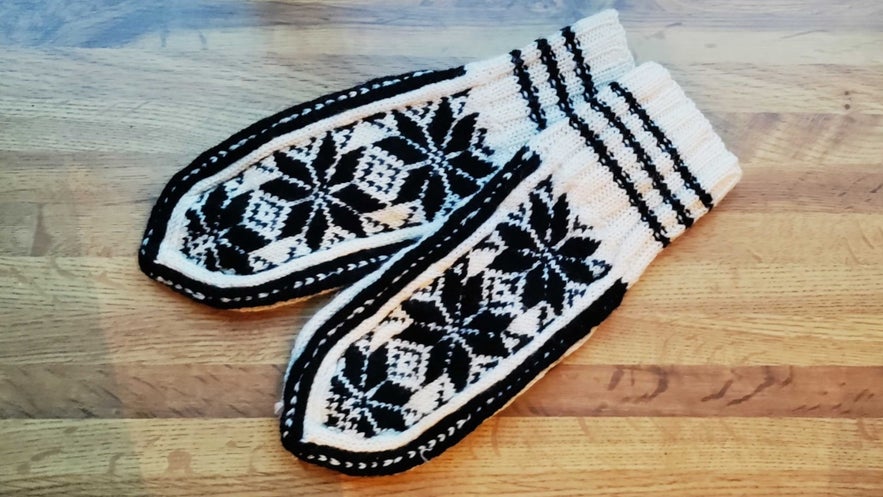 If you want something more unique, you can create your own souvenir at this skrimsli "wool monster" workshop! It can be a super fun and informative activity for families as you'll learn about Icelandic folklore and create your own adorable creature to take home. The workshop takes around an hour and is located in the town of Gardabaer. It's just a 10-minute drive from central Reykjavik and is accessible by public bus.
If you want something more unique, you can create your own souvenir at this skrimsli "wool monster" workshop! It can be a super fun and informative activity for families as you'll learn about Icelandic folklore and create your own adorable creature to take home. The workshop takes around an hour and is located in the town of Gardabaer. It's just a 10-minute drive from central Reykjavik and is accessible by public bus.
Entdecke unsere beliebten Kultur-Touren
Reykjavik-City-Card für 24 Stunden mit freiem Eintritt in Museen, Galerien und geothermische Bäder
10-tägige Mietwagen-Rundreise über die gesamte Ringstraße Islands mit Top-Attraktionen & Snaefellsnes
Flexible 48-Stunden-City-Card für Reykjavik mit freiem Eintritt in Museen, Galerien und Geothermalbäder
Summary of the Lopapeysa Sweater and Icelandic Wool

The Icelandic lopapeysa is one of the most recognizable symbols of Iceland and an important part of the country's history. It's loved by the locals as an informal national costume, and you can find authentic sweaters being sold all over the country.
It's very practical as it's warm and light, thanks to the hardy features of the Icelandic sheep wool, and it's the best thing to wear during the colder months. During a visit, make sure to check out the iconic lopapeysa sweater and maybe grab one for yourself to bring home your own piece of Icelandic culture!
Will you pick up an Icelandic lopapeysa sweater when you visit Iceland? What kind of sweater would you choose? Do you already have your own lopapeysa or another Icelandic wool item? Share your thoughts with us in the comments below!
Weitere interessante Artikel
Islands Einwohner | Was definiert die Isländer?
Was sind stereotype „isländische Eigenschaften“? Wie kann man einen Isländer definieren? Lies weiter, um alles darüber zu erfahren, was die rund 360.000 Einwohner dieses Inselstaates traditionel...WeiterlesenIsländisches Alphabet und Grundlagen der Sprache
Ist die isländische Sprache schwierig? Wie spricht man Reykjavik oder – besser noch – Eyjafjallajökull aus? Wie liest man das isländische Alphabet? Gibt es Ähnlichkeiten zwischen dem Deutschen un...WeiterlesenWikinger und nordische Götter in Island
Wer waren die frühen Wikinger-Siedler, die Islands Küste erreichten, und wer waren die Götter, die sie verehrten? Inwiefern ist dieses Wikinger-Erbe auch heute noch sichtbar in Island, und warum hab...Weiterlesen

Lade Islands größten Reisemarktplatz auf dein Handy herunter, um deine gesamte Reise an einem Ort zu verwalten
Scanne diesen QR-Code mit der Kamera deines Handys und klicke auf den angezeigten Link, um Islands größten Reisemarktplatz in deine Tasche zu laden. Füge deine Telefonnummer oder E-Mail-Adresse hinzu, um eine SMS oder E-Mail mit dem Download-Link zu erhalten.




















